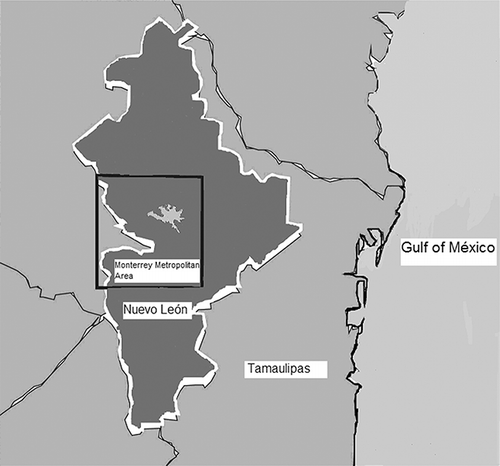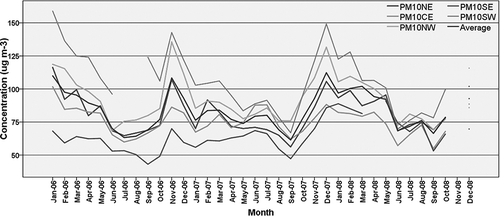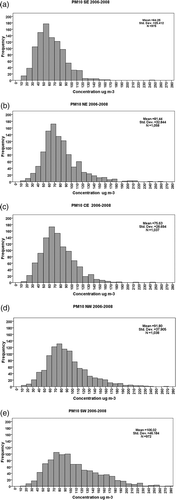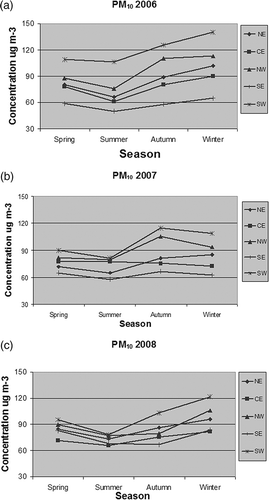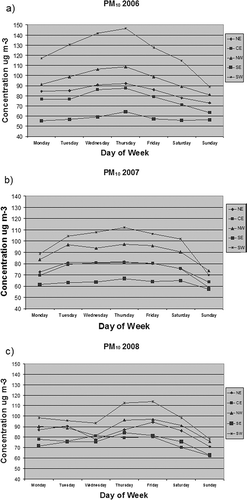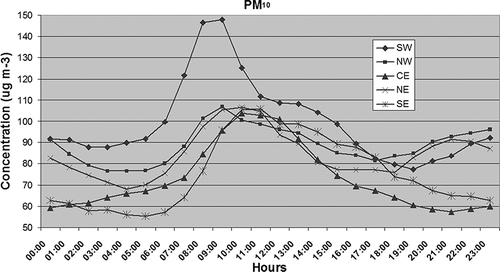ABSTRACT
The Monterrey Metropolitan Area (MMA) is the third largest city in México. Few studies have been carried out regarding its air pollution. The aim of this study was to analyze the temporal behavior of PM10 (particulate matter ≤10 μm in aerodynamic diameter). Data reported by the “Sistema Integral de Monitoreo Ambiental” (Integrated Environmental Monitoring System) network from 2006 to 2008 were used. PM10 levels were compared among the stations by year, season, and day of week. A bootstrap technique was used to obtain subsamples to which Student's t test and ANOVA were applied. PM10 levels were high and exceeded the annual limit of 50 μg/m3 set up by the Mexican standard Norma Oficial Mexicana NOM-025-SSA1-1993. These levels could have serious health effects. The southwest zone of MMA had the highest levels of PM10 during the period studied. Winter was the most polluted season, and summer was the least polluted season. Thursday and Friday were the most polluted days, and Sunday was the least polluted day. The hours with the highest levels of PM10 were 8:00 to 10:00 a.m., whereas nighttime hours were the cleanest.
Air pollution in MMA, an important city in México, has seldom been studied. The results reported in this work clearly indicate that PM10 levels are high and that it is necessary to establish actions to reduce them. These actions, such as restricting vehicular traffic or limiting industrial emissions, must consider the temporal variations in PM10.
INTRODUCTION
Airborne particulate matter is an important air pollutant. Particles less than 2.5 μm in aerodynamic diameter (PM2.5) are generally referred to as “fine,” those from 2.5 to 10 μm diameter (PM2.5–10) as “coarse,” and those smaller than 10 μm diameter (PM10) as inhalable particles.Citation1–3
PM10 can be formed by mechanical disruption (crushing, grinding, and abrasion of surfaces), evaporation of sprays, suspension of dust, and reaction of gases in or on particles. Furthermore, meteorological variables affect the levels of PM10.Citation4,Citation5 Precipitation scavenges the airborne particles and gases, so these pollutants can influence precipitation chemistry trends.Citation6
Atmospheric particulate matter scatters or absorbs light, thus degrading visibility by reducing the clarity and distance that can be discerned by the human eye.Citation7 Moreover, recent epidemiological studies have shown that elevated ambient concentrations of PM10 may lead to increased mortality and morbidity. Studies have reported mean increases in mortality by 1% for each 10-μg/m3 increase of ambient PM10.Citation1,Citation7–10 Because of this, the implementation of actions that prevent severe pollution episodes should consider the temporal behavior of pollutants.
Large cities often have high levels of PM10 because of industrial activity and vehicular traffic. In México the largest cities are México City, Guadalajara, and Monterrey.
The Monterrey Metropolitan Area (MMA) is the third largest city in México and extends from 25° 15′ to 26° 30′ north latitude and 99° 40′ to 101° 10′ west longitude (). The area is limited by the coastal plain of the Gulf of Mexico and the Sierra Madre Oriental mountain range.Citation11 It includes the municipalities of Monterrey, San Nicolás de los Garza, Apodaca, Guadalupe, San Pedro Garza Garcia, Santa Catarina, General Escobedo, García, and Juárez of Nuevo León.Citation12 In 2005, the number of inhabitants and vehicles were 3,412,421 and 1,243,871, respectively, which are likely to be even larger today. Similarly, there are approximately 9700 industrial units,Citation13 with the principal industries in Monterrey being metal-lurgical, cement, solvents, and glass. Temperatures tend to be extreme, with values exceeding 35 °C during summer and below 8 °C during winter.
Since November 20, 1992, a network of five stations has continuously monitored PM10, PM2.5, carbon mon-oxide, ozone, nitrogen dioxide, and sulfur dioxide. At all stations, the analysis of PM10 is by beta attenuation with a Thermo Scientific ambient particulate monitor (TEOM 1405-DF) The station locations, shown in , are
Figure 2. “Sistema Integral de Monitoreo Ambiental” network (Integrated Environmental Monitoring System).
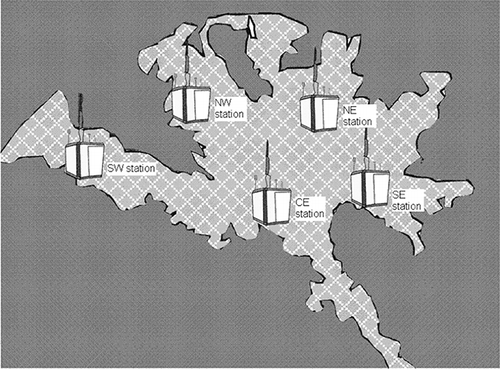
| 1. | Southeast station (SE), located within the “La pastora” park at Guadalupe, Nuevo León, 25°40′ 06″ north, 100°14′ 54″ west, 490 m mean sea level (msl). This station is located downwind of a limited industrial corridor in a highly populated area. | ||||
| 2. | Northeast station (NE), located in the Unidad Laboral neighborhood in San Nicolas de los Garza, 25°44′ 42″ north, 100°15′ 17″ west, 500 m msl. This station is located in a highly populated area. | ||||
| 3. | Center station (CE), located at the water facility “Agua y Drenaje de Monterrey” in the Obispado area, 25°40′ 32″ north, 100 °20′ 18″ west, 556 m msl. This station is close to the center of MMA. | ||||
| 4. | Northwest station (NW), located in the San Bern-abé neighborhood of Monterrey, 25°45′ 11″ north, 100°22′ 11″ west, 554 m msl. This station is located downwind of industrial and heavy traffic sources of MMA. | ||||
| 5. | Southwest station (SW), located in the Santa Catarina neighborhood of downtown of Monterrey, 25°40′ 30″ north, 100°27′ 30″ west, 678 m msl. This station is situated downwind of industrial sources in Monterrey, San Pedro García, and Santa Catarina.Citation14 | ||||
The network has reported that PM10 routinely exceeds the annual average limit of 50 μg/m3 set up by the Mexican standard Norma Oficial Mexicana NOM-025-SSA1-1993.Citation15 At present, few studies have been done in MMA regarding air pollution. The aim of this work was to statistically analyze the temporal and spatial pattern of PM10 during 2006–2008, a 3-yr period of continuous monitoring.
METHODS
Data
The original data were previously validated by the “Sistema Integral de Monitoreo Ambiental” (Integrated Environmental Monitoring System) during 2006–2008. Data reported during the first 2 yr were daily averages, with hourly averages reported for 2008. The latter year was used for diurnal analysis and was also included in the analysis of months, seasons, and weekdays. The meteorological variables of temperature, wind speed, wind direction, and relative humidity (RH) were also obtained. A minimum data requirement of 75% was used for calculation of monthly, seasonal, and daily averages.
Analysis
In this study, bootstrap resampling was applied to test the differences in the mean of PM10 concentrations between different seasons and days of the week. Bootstrap resampling is a statistical technique that generates many artificial samples from the observed data. Given a set of observations from a population, the nonparametric maximum likelihood estimator in the population (from which the sample is drawn) is the sample itself if there is no other information available about the population. The artificial samples can be used in several tests for determining if the observed value, treated as one random sample from the distribution, occurs by chance given a null hypothesis. In this case, a mean of 1000 subsamples of 10 values each was used and a traditional Student's t distribution, oneway ANOVA was conducted to determine the statistical significance of the mean value.Citation16 Box Sampler software was used for bootstrap resampling and SPSSV.10 (IBM) was used for ANOVA and descriptive statistics. Wind speed and wind direction were integrated in wind rose plots using WRPLOT View software from Lakes Environmental.Citation17
RESULTS AND DISCUSSION
Arithmetic mean, standard deviation, and maximum and minimum levels of PM10 during the period of 2006–2008 are shown in . The missing data were minor to 11%. As can be seen, the most polluted zone is SW, with concentrations ranging from 66.83 to 158.9 μg/m3, and the least polluted zone is SE, with concentrations ranging from 43.09 to 90.84 μg/m3. From , the largest standard deviation value is found in the SW zone. In all zones, the annual limit (50 μg/m3) established by the Mexican standard NOM-025-SSA1–1993 was exceeded (). Concentrations are consistently high relative to the Mexican standard, especially in the SW zone, where the arithmetic mean of 106.42 μg/m3 was twice the standard. High levels of traffic and industrial activities in the zone may explain the elevated PM10 in the SW. Further more, the predominant direction of wind in MMA is easterly, which transports pollutants from the other zones toward Santa Catarina (SW). In addition, the Sierra Madre Oriental hills and Cerro del Topo topographic features act as natural barriers to channel pollutants into this zone.
Table 1. Descriptive statistics of PM10 during 2006 –2008 (μg/m3)
Frequency Distribution
All data were grouped in bins of 10 μg/m3. The results are shown in The SW zone had the highest range of PM10 concentration, with a maximum frequency from 70 to 100 μg/m3. The maximum frequency in the SE zone ranged from 50 to 60 μg/m3 and was thus the cleanest zone. In the NE and CE zones, the maximum frequencies were in the range of 60–70 μg/ m3. For the NW zone, the maximum frequency was in the range of 70–90 μg/m3.
Seasonal and Spatial Variation of PM10 Levels
The seasonal variation of PM10 can be seen in and For all 3 yr, winter was the season with highest PM10 levels in all five zones. The differences between zones and seasons were the same for each year. The most polluted zone was SW, and the least polluted zone was SE (P = 0.05). Winter was the most polluted season (P = 0.05). The high wintertime PM10 levels can be explained by increased vehicular traffic associated with the New Year and Christmas holidays as well as changes in meteorological variables taking place during December. Summer was the season with the lowest PM10 levels in all zones. Meteorological variables including high RH and precipitation can explain the low levels during summer.
Table 2. Descriptive statistics of PM10 by season during 2006–2008 (μg/m3)
Day-of-the-Week Variation of PM10 Levels
Variation in PM10 levels according to day of the week is shown in The most polluted day was Thursday. A one-sided ANOVA test shows that there is a significant difference between PM10 levels on different days of the week, with Thursday being the most polluted day and Sunday the least polluted day. This pattern is not uncommon because Thursday and Friday were expected to be the most polluted days. On those days, people go out to have fun, go shopping, or simply visit other places. Sunday is the least polluted day and can be explained by fewer activities and less vehicular traffic as well as reduced industrial activity.
Diurnal Variation
For the analysis of diurnal variation, only data for 2009 were used. The diurnal pattern of PM10 is shown in The average daily pattern of PM10 based on hourly mean concentration is very similar in all zones. The highest levels of PM10 were during the morning. In the SW and NW zones, the hour with the highest concentration was 8:00 a.m., whereas in the CE and NE zones, the hour with the highest level was 9:00 a.m. The hour with the highest concentration in the SE zone was 10:00 a.m. Morning and afternoon traffic maxima in MMA occur at approximately 8:00 a.m. and 6:00 p.m., respectively. Traffic is thus unlikely to explain the single peak in the morning. Meteorological variables, including temperature inversions, probably contribute to the morning peak.
Correlation with Meteorological Variables
The relation between PM10 concentration and meteorological variables is shown in . There is a negative correlation between wind speed and PM10 concentration in all zones except SE, with the strongest correlation in the SW (−0.438). A negative correlation between PM10 and RH was also observed in all zones, with the NE zone having the strongest correlation. There was a positive correlation between temperature and PM10 in all zones except the SW zone.
Table 3. Pearson correlation coefficients between PM10 and meteorological variables
With respect to wind direction, the wind roses for the seasons of 2008 in the SW zone () show that the predominant direction in MMA is from east to west and that the wind speed is higher in summer than in winter. The wind direction probably influences the high PM10levels of the SW zone by transporting pollutants toward this zone. It is necessary to remember that this zone is adjacent to the Sierra Madre Oriental mountain range, which acts like a barrier to dispersion of PM10. This fact and the temporal variation in wind speed could explain the inconsistency between the high levels of PM10 in winter and the positive correlation between temperature and PM10.
Figure 8. Wind roses by season during 2008 in the SW zone for (a) winter, (b) spring, (c) summer, and (d) autumn.
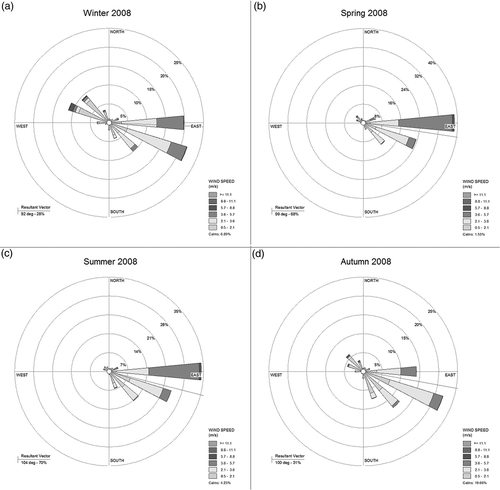
The temperature inversion, a thermally stable atmospheric layer in which temperature increases with increasing altitude, appears to have a controlling influence on the elevated PM10 concentrations observed during morning and during winter. Using upper-air meteorological data for the 45-yr period 1965–2009 obtained from the U.S. National Climatic Data Center,Citation18 monthly climatological statistics relating to the morning temperature inversion were determined for Monterrey. The morning temperature inversion is approximately 1000 m deep during the months of November through February. In October and March, the inversion is approximately 300 m deep, and from April through September the inversion is typically quite shallow, if present. The presence of the temperature inversion, especially during winter, presents a likely explanation for the morning peak in PM10 concentration. Turbulent dispersion is reduced during temperature inversions, often leading to elevated pollutant concentrations. In addition, low winter wind speeds, which correlate with high PM10 concentrations (), are typically associated with strong temperature inversions.
CONCLUSIONS
PM10 levels in MMA are high and exhibit significant spatial and seasonal variation. High PM10 levels are likely because of a combination of temperature inversions, road traffic density, substantial industrial activities, and meteorological conditions. The SW zone was the most polluted and the SE zone was the cleanest during the studied period. In all zones, the annual limit of 50 μg/m3 established by Mexican standard NOM-025-SSA1-1993 was exceeded and may have reached an alarming levels in the SW zone (Santa Catarina). The most polluted day of the week was Thursday and the cleanest day was Sunday. The most polluted season was winter and the cleanest was summer. Studies concerning the chemical composition of PM10 and PM2.5 must be carried out to establish source apportionment. It is necessary to perform actions that control PM10 pollution levels in MMA.
REFERENCES
- 2004 . Air Quality Criteria for Particulate Matter, Volume 1 , Research Triangle Park , NC : U.S. Environmental Protection Agency; Office of Research and Development .
- 2008 . Integrated Science Assessment for Particulate Matter , Research Triangle Park , NC : First External Review Draft; U.S. Environmental Protection Agency; National Center for Environmental Assessment .
- Suh , H.H. , Bahadori , T. , Vallarino , J. and Spengler , J.D. 2000 . Criteria Air Pollutants and Toxic Air Pollutants . Environ. Health Perspect. , 108 ( Suppl 4 ) : 625 – 633 .
- Harrison , U.R.M. and Jianxin , Y. 2000 . Particulate Matter in the Atmosphere: Which Particle Properties Are Important for Its Effects on Health? . Sci Total Environ. , 249 : 85 – 101 .
- Pöschl , U. 2005 . Atmospheric Aerosols: Composition, Transformation, Climate and Health Effects . Angew. Chem. Int. Ed. , 44 : 7520 – 7540 .
- Lehmann , C.M.B. , Bowersox , V.C. and Larson , S.M. 2005 . Spatial and Temporal Trends of Precipitation Chemistry in the United States, 1985–2002 . Environ. Pollut. , 135 : 347 – 361 .
- Brewer , P.F. and Adlhoch , J.P. 2005 . Trends in Speciated Fine Particulate Matter and Visibility across Monitoring Networks in the Southeastern United States . Journal of the Air & Waste Management Association , 55 : 1663 – 1674 .
- Pope , C.A. and Dockery , D.W. 2006 . Health Effects of Fine Particulate Air Pollution: Lines That Connect . Journal of the Air & Waste Management Association , 56 : 709 – 742 .
- Brunekreef , B. and Holgate , S.T. 2002 . Air Pollution and Health . Lancet , 360 : 1233 – 1242 .
- Künzli , N. and Tager , I.B. 2005 . Air Pollution: from Lung to Heart . Swiss Med. Wkly. , 135 : 697 – 702 .
- Guajardo , A. 2002 . Strategic Analysis of the Metropolitan Area of Monterrey: a Diagnostic for Development (in Spanish) , Vol. I , Havana , , Cuba : University of Havana . Center for Demographic Studies
- Executive Decree of the State; Government Gazette; November 30, 1988.
- 2005 . Annual Statistics of Nuevo Léon , Monterrey Nuevo León , , Mexico : National Institute of Statistics and Geography .
- Environmental and Natural Resource Protection Agency; Integrated Environmental Monitoring System; Government of Nuevo León http://www.nl.gob.mx/?P=med_amb_mej_amb_sima (http://www.nl.gob.mx/?P=med_amb_mej_amb_sima) (Accessed: 2010 ).
- Environmental Health. Criteria for Evaluating the Quality of Air Environment, with Respect to Less than 10 μm Particles (PM10). Permissible Value for the Concentration of Particles under 10 μm (PM10) in Ambient Air as a Measure of Protection the Health of the Population . NOM-025-SSA1-1993 . United Mexican States; Ministry of Health: Mexico City, Mexico
- Pun , B.K. and Seigneur , C. 2001 . Data Analysis for a Better Understanding of the Weekday/Weekend Ozone and PM Differences , San Ramon , CA : Prepared for the Coordinating Research Council by Atmospheric and Environmental Research . A-36B
- Lakes Environmental Software, 1995–2010 http://www.weblakes.com (http://www.weblakes.com) (Accessed: 2010 ).
- Durre , M. , Vose , R.S. and Wuertz , D.B. 2006 . Overview of the Integrated Global Radiosonde Archive . J. Climate , 19 : 53 – 68 .
- Girgzdiene , R. and Rameikyte , R. 2007 . Variation of PM10 Mass and Aerosol Number Concentration in Siauliai . J. Environ. Eng. Landsc. Manage. , 15 : 47 – 53 .
- Kakooei , H. and Kakooei , A. 2007 . Measurement of PM10, PM2.5, and TSP Particle Concentrations in Tehran, Iran . J. Appl. Sci. , 7 : 3081 – 3085 .
- Yang , K.L. 2002 . Spatial and Seasonal Variation of PM10 Mass Concentration in Taiwan . Atmos. Environ. , 36 : 3403 – 3411 .
